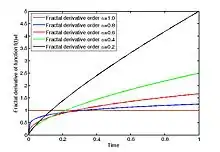Fractal derivative
In applied mathematics and mathematical analysis, the fractal derivative or Hausdorff derivative is a non-Newtonian generalization of the derivative dealing with the measurement of fractals, defined in fractal geometry. Fractal derivatives were created for the study of anomalous diffusion, by which traditional approaches fail to factor in the fractal nature of the media. A fractal measure t is scaled according to tα. Such a derivative is local, in contrast to the similarly applied fractional derivative.
Physical background
Porous media, aquifers, turbulence, and other media usually exhibit fractal properties. The classical physical laws such as Fick's laws of diffusion, Darcy's law, and Fourier's law are no longer applicable for such media, because they are based on Euclidean geometry, which doesn't apply to media of non-integer fractal dimensions. The basic physical concepts such as distance and velocity in fractal media are required to be redefined; the scales for space and time should be transformed according to (xβ, tα). The elementary physical concepts such as velocity in a fractal spacetime (xβ, tα) can be redefined by:
- ,
where Sα,β represents the fractal spacetime with scaling indices α and β. The traditional definition of velocity makes no sense in the non-differentiable fractal spacetime.
Definition
Based on above discussion, the concept of the fractal derivative of a function u(t) with respect to a fractal measure t has been introduced as follows:
- ,
A more general definition is given by
- .
Motivation
The derivatives of a function f can be defined in terms of the coefficients ak in the Taylor series expansion:
From this approach one can directly obtain:
This can be generalized approximating f with functions (xα-(x0)α)k:
note: the lowest order coefficient still has to be b0=f(x0), since it's still the constant approximation of the function f at x0.
Again on can directly obtain:
Properties
Expansion coefficients
Just like in the Taylor series expansion, the coefficients bk can be expressed in terms of the fractal derivatives of order k of f:
Proof idea: assuming exists, bk can be written as
one can now use and since
Connection with Derivative
If for a given function f both the derivative Df and the fractal derivative Dαf exists, one can find an analog to the chain rule:
The last step is motivated by the Implicit function theorem which, under appropriate conditions, gives us dx/dxα = (dxα/dx)−1
Similarly for the more general definition:

Application in anomalous diffusion
As an alternative modeling approach to the classical Fick's second law, the fractal derivative is used to derive a linear anomalous transport-diffusion equation underlying anomalous diffusion process,
where 0 < α < 2, 0 < β < 1, and δ(x) is the Dirac delta function.
In order to obtain the fundamental solution, we apply the transformation of variables
then the equation (1) becomes the normal diffusion form equation, the solution of (1) has the stretched Gaussian form:
The mean squared displacement of above fractal derivative diffusion equation has the asymptote:
Fractal-fractional calculus
The fractal derivative is connected to the classical derivative if the first derivative of the function under investigation exists. In this case,
- .
However, due to the differentiability property of an integral, fractional derivatives are differentiable, thus the following new concept was introduced
The following differential operators were introduced and applied very recently.[1] Supposing that y(t) be continuous and fractal differentiable on (a, b) with order β, several definitions of a fractal–fractional derivative of y(t) hold with order α in the Riemann–Liouville sense:[1]
- Having power law type kernel:
- Having exponentially decaying type kernel:
,
- Having generalized Mittag-Leffler type kernel:
The above differential operators each have an associated fractal-fractional integral operator, as follows:[1]
- Power law type kernel:
- Exponentially decaying type kernel:
.
- Generalized Mittag-Leffler type kernel:
. FFM is refereed to fractal-fractional with the generalized Mittag-Leffler kernel.
References
- Atangana, Abdon; Sania, Qureshi (2019). "Modeling attractors of chaotic dynamical systems with fractal–fractional operators". Chaos, Solitons & Fractals. 123: 320–337. Bibcode:2019CSF...123..320A. doi:10.1016/j.chaos.2019.04.020.
- Chen, W. (2006). "Time–space fabric underlying anomalous diffusion". Chaos, Solitons and Fractals. 28 (4): 923–929. arXiv:math-ph/0505023. Bibcode:2006CSF....28..923C. doi:10.1016/j.chaos.2005.08.199. S2CID 18369880.
- Kanno, R. (1998). "Representation of random walk in fractal space-time". Physica A. 248 (1–2): 165–175. Bibcode:1998PhyA..248..165K. doi:10.1016/S0378-4371(97)00422-6.
- Chen, W.; Sun, H.G.; Zhang, X.; Korosak, D. (2010). "Anomalous diffusion modeling by fractal and fractional derivatives". Computers and Mathematics with Applications. 59 (5): 1754–8. doi:10.1016/j.camwa.2009.08.020.
- Sun, H.G.; Meerschaert, M.M.; Zhang, Y.; Zhu, J.; Chen, W. (2013). "A fractal Richards' equation to capture the non-Boltzmann scaling of water transport in unsaturated media". Advances in Water Resources. 52 (52): 292–5. Bibcode:2013AdWR...52..292S. doi:10.1016/j.advwatres.2012.11.005. PMC 3686513. PMID 23794783.
- Cushman, J.H.; O'Malley, D.; Park, M. (2009). "Anomalous diffusion as modeled by a nonstationary extension of Brownian motion". Phys. Rev. E. 79 (3): 032101. Bibcode:2009PhRvE..79c2101C. doi:10.1103/PhysRevE.79.032101. PMID 19391995.
- Mainardi, F.; Mura, A.; Pagnini, G. (2010). "The M-Wright Function in Time-Fractional Diffusion Processes: A Tutorial Survey". International Journal of Differential Equations. 2010: 104505. arXiv:1004.2950. Bibcode:2010arXiv1004.2950M. doi:10.1155/2010/104505. S2CID 37271918.